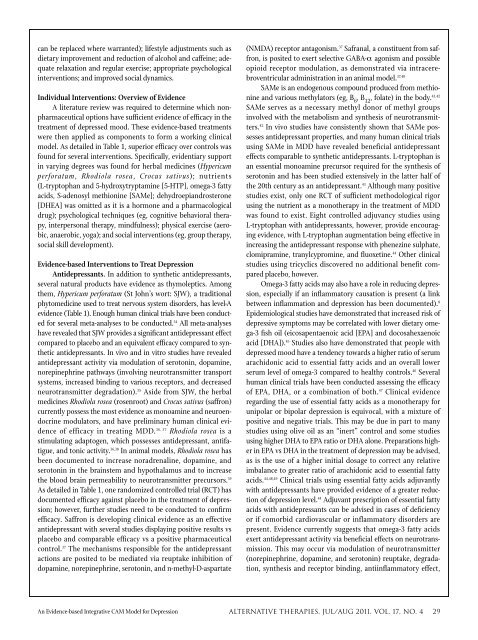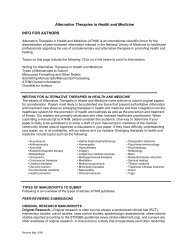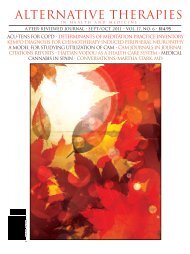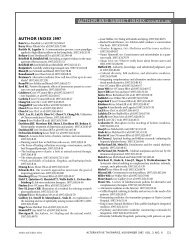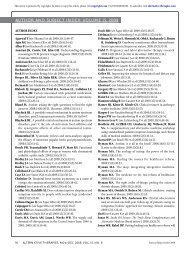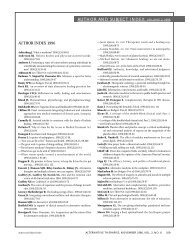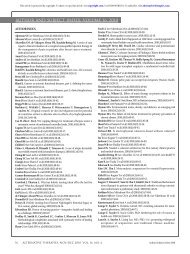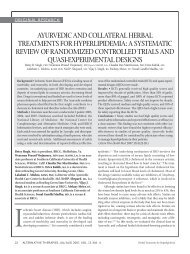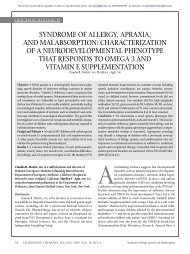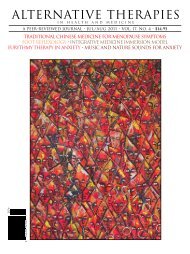Alternative Therapies In Health And Medicine
Alternative Therapies In Health And Medicine
Alternative Therapies In Health And Medicine
Create successful ePaper yourself
Turn your PDF publications into a flip-book with our unique Google optimized e-Paper software.
can be replaced where warranted); lifestyle adjustments such as<br />
dietary improvement and reduction of alcohol and caffeine; adequate<br />
relaxation and regular exercise; appropriate psychological<br />
interventions; and improved social dynamics.<br />
<strong>In</strong>dividual <strong>In</strong>terventions: Overview of Evidence<br />
A literature review was required to determine which nonpharmaceutical<br />
options have sufficient evidence of efficacy in the<br />
treatment of depressed mood. These evidence-based treatments<br />
were then applied as components to form a working clinical<br />
model. As detailed in Table 1, superior efficacy over controls was<br />
found for several interventions. Specifically, evidentiary support<br />
in varying degrees was found for herbal medicines (Hypericum<br />
perforatum, Rhodiola rosea, Crocus sativus); nutrients<br />
(L-tryptophan and 5-hydroxytryptamine [5-HTP], omega-3 fatty<br />
acids, S-adenosyl methionine [SAMe]; dehydroepiandrosterone<br />
[DHEA] was omitted as it is a hormone and a pharmacological<br />
drug); psychological techniques (eg, cognitive behavioral therapy,<br />
interpersonal therapy, mindfulness); physical exercise (aerobic,<br />
anaerobic, yoga); and social interventions (eg, group therapy,<br />
social skill development).<br />
Evidence-based <strong>In</strong>terventions to Treat Depression<br />
Antidepressants. <strong>In</strong> addition to synthetic antidepressants,<br />
several natural products have evidence as thymoleptics. Among<br />
them, Hypericum perforatum (St John’s wort: SJW), a traditional<br />
phytomedicine used to treat nervous system disorders, has level-A<br />
evidence (Table 1). Enough human clinical trials have been conducted<br />
for several meta-analyses to be conducted. 34 All meta-analyses<br />
have revealed that SJW provides a significant antidepressant effect<br />
compared to placebo and an equivalent efficacy compared to synthetic<br />
antidepressants. <strong>In</strong> vivo and in vitro studies have revealed<br />
antidepressant activity via modulation of serotonin, dopamine,<br />
norepinephrine pathways (involving neurotransmitter transport<br />
systems, increased binding to various receptors, and decreased<br />
neurotransmitter degradation). 35 Aside from SJW, the herbal<br />
medicines Rhodiola rosea (rosenroot) and Crocus sativus (saffron)<br />
currently possess the most evidence as monoamine and neuroendocrine<br />
modulators, and have preliminary human clinical evidence<br />
of efficacy in treating MDD. 36, 37 Rhodiola rosea is a<br />
stimulating adaptogen, which possesses antidepressant, antifatigue,<br />
and tonic activity. 36,38 <strong>In</strong> animal models, Rhodiola rosea has<br />
been documented to increase noradrenaline, dopamine, and<br />
serotonin in the brainstem and hypothalamus and to increase<br />
the blood brain permeability to neurotransmitter precursors. 39<br />
As detailed in Table 1, one randomized controlled trial (RCT) has<br />
documented efficacy against placebo in the treatment of depression;<br />
however, further studies need to be conducted to confirm<br />
efficacy. Saffron is developing clinical evidence as an effective<br />
antidepressant with several studies displaying positive results vs<br />
placebo and comparable efficacy vs a positive pharmaceutical<br />
control. 37 The mechanisms responsible for the antidepressant<br />
actions are posited to be mediated via reuptake inhibition of<br />
dopamine, norepinephrine, serotonin, and n-methyl-D-aspartate<br />
(NMDA) receptor antagonism. 37 Safranal, a constituent from saffron,<br />
is posited to exert selective GABA-α agonism and possible<br />
opioid receptor modulation, as demonstrated via intracerebroventricular<br />
administration in an animal model. 37,40<br />
SAMe is an endogenous compound produced from methionine<br />
and various methylators (eg, B 6<br />
, B 12<br />
, folate) in the body. 41,42<br />
SAMe serves as a necessary methyl donor of methyl groups<br />
involved with the metabolism and synthesis of neurotransmitters.<br />
42 <strong>In</strong> vivo studies have consistently shown that SAMe possesses<br />
antidepressant properties, and many human clinical trials<br />
using SAMe in MDD have revealed beneficial antidepressant<br />
effects comparable to synthetic antidepressants. L-tryptophan is<br />
an essential monoamine precursor required for the synthesis of<br />
serotonin and has been studied extensively in the latter half of<br />
the 20th century as an antidepressant. 43 Although many positive<br />
studies exist, only one RCT of sufficient methodological rigor<br />
using the nutrient as a monotherapy in the treatment of MDD<br />
was found to exist. Eight controlled adjuvancy studies using<br />
L-tryptophan with antidepressants, however, provide encouraging<br />
evidence, with L-tryptophan augmentation being effective in<br />
increasing the antidepressant response with phenezine sulphate,<br />
clomipramine, tranylcypromine, and fluoxetine. 44 Other clinical<br />
studies using tricyclics discovered no additional benefit compared<br />
placebo, however.<br />
Omega-3 fatty acids may also have a role in reducing depression,<br />
especially if an inflammatory causation is present (a link<br />
between inflammation and depression has been documented). 8<br />
Epidemiological studies have demonstrated that increased risk of<br />
depressive symptoms may be correlated with lower dietary omega-3<br />
fish oil (eicosapentaenoic acid [EPA] and docosahexaenoic<br />
acid [DHA]). 45 Studies also have demonstrated that people with<br />
depressed mood have a tendency towards a higher ratio of serum<br />
arachidonic acid to essential fatty acids and an overall lower<br />
serum level of omega-3 compared to healthy controls. 46 Several<br />
human clinical trials have been conducted assessing the efficacy<br />
of EPA, DHA, or a combination of both. 47 Clinical evidence<br />
regarding the use of essential fatty acids as a monotherapy for<br />
unipolar or bipolar depression is equivocal, with a mixture of<br />
positive and negative trials. This may be due in part to many<br />
studies using olive oil as an “inert” control and some studies<br />
using higher DHA to EPA ratio or DHA alone. Preparations higher<br />
in EPA vs DHA in the treatment of depression may be advised,<br />
as is the use of a higher initial dosage to correct any relative<br />
imbalance to greater ratio of arachidonic acid to essential fatty<br />
acids. 44,48,49 Clinical trials using essential fatty acids adjuvantly<br />
with antidepressants have provided evidence of a greater reduction<br />
of depression level. 44 Adjuvant prescription of essential fatty<br />
acids with antidepressants can be advised in cases of deficiency<br />
or if comorbid cardiovascular or inflammatory disorders are<br />
present. Evidence currently suggests that omega-3 fatty acids<br />
exert antidepressant activity via beneficial effects on neurotransmission.<br />
This may occur via modulation of neurotransmitter<br />
(norepinephrine, dopamine, and serotonin) reuptake, degradation,<br />
synthesis and receptor binding, antiinflammatory effect,<br />
An Evidence-based <strong>In</strong>tegrative CAM Model for Depression<br />
ALTERNATIVE THERAPIES, jul/aug 2011, VOL. 17, NO. 4 29


